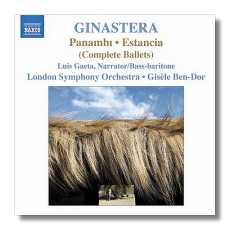
The Internet's Premier Classical Music Source
Related Links
- Ginastera Reviews
- Latest Reviews
- More Reviews
-
By Composer
-
Collections
DVD & Blu-ray
Books
Concert Reviews
Articles/Interviews
Software
Audio
Search Amazon
Recommended Links
Site News
 CD Review
CD Review
Alberto Ginastera

Ballets
- Panambí, Op. 1
- Estancia, Op. 8 1
1 Luis Gaeta, narrator/bass-baritone
London Symphony Orchestra/Gisèle Ben-Dor
Naxos 8.557582 DDD 72:32
Summary for the Busy Executive: Stravinsky and Bartók on the pampas.
Ginastera's music falls into roughly four periods: an Impressionistic early phase; a vigorous Modernist phase; a highly experimental period, strongly influenced by Berg; and a grand synthesis of elements from the previous three. Panambí and Estancia come from the first two periods. For many years, both suffered the same fate. The composer had written full-length scores. One reason or another delayed the première of the complete works, and conductors presented excerpts instead. I became acquainted with parts of Panambí through an old Everest LP led by Eugene Goossens and a suite from Estancia on a Leonard Bernstein collection of Latin-American (and Latin-American-inspired) orchestral showstoppers. Both were attractive, but not especially gripping. I waited a long time for a recording of the entire scores, which, when it finally arrived, hit with the force of revelation. Indeed, as far as I can tell, this is the first recording of the entire Estancia, complete with soloist, although earlier near-complete versions have appeared.
It turns out that the stature of both Panambí and Estancia grows significantly when you finally hear all the music. Ginastera has long been considered one of the finest composers of his time, but it's taken more than sixty years for the most elementary respect to be paid to his work.
Ginastera designated Panambí his Op. 1, but he had withheld or destroyed at least fifty earlier works in characteristically ruthless self-criticism. He reached only slightly more than fifty opus numbers at the time of his death, unlike Handel who probably could have reached fifty opera between breakfast and lunch. The ballet exemplifies one strain of Latin-American nationalism from the Twenties and Thirties: the evocation of indigenous Indian culture, as shown by such works as Chávez's Sinfonia India and piano concerto and Villa-Lôbos's Amazonas and Uirapurù. Ginastera took an authentic folk tale of love and sorcery from a regional tribe. The idiom is that of early Stravinsky, before he lost his Debussyan roots. One can trace much of the sound of the ballet to Firebird, especially in the finale, a depiction of dawn, in which Ginastera transports the last pages of Firebird to Argentina.
A Latin-American tour by Ballet Caravan and a performance of Aaron Copland's Billy the Kid, as well as an invitation to compose from the company founder and director, Lincoln Kirstein, inspired Ginastera to try something similar, although again in Argentinean terms. Instead of the Wild West cowboy, Ginastera turned to the gaucho and José Hernández's epic, Martin Fierro. Ginastera takes a few lines, some declaimed, some sung, but jettisons the poem's plot in favor of a city-slicker-wins-the-ranch-girl story. However, as in Billy the Kid, the plot is the least of the ballet. Ginastera has found musical symbols for the Argentinean pampas, as Copland did for the American prairie. Much of the music derives from Bartók (and at Bartók's level), although the beat and melos remain echt-Latin-American. The piano plays the pitches of the open strings of the guitar, and music taps out many folk-dance rhythms – especially the malambo, to reappear prominently throughout Ginastera's later output, and not always in explicit folk contexts. Each section of the ballet shows superb craft and throws off great excitement – every note perfectly placed without compromising the sense of abandon – perhaps the reasons why the four-dance suite has remained popular, especially the showstopping finale. And yet the sections you hardly ever hear are not only beautiful in themselves (with the outstanding solo "Triste," the quintessence of yearning), but impart greater profundity to the score. One experiences more "roundedness" of emotional space, a hint at the vast loneliness of the pampas.
Ben-Dor and the London Symphony do very well indeed. In fact, I would recommend this recording before all the others, and not simply because this is the only truly complete Estancia. The coupling with the complete Panambí makes perfect sense. Since I know no Spanish beyond what I hear in old Westerns, I can't judge Luis Gaeta's reading of the Hernández excerpts, but his singing is wonderful. I have heard slightly more exciting recordings of the Estancia suite, but the London Symphony does fine, thank you. Only a virtuoso orchestra has any chance with Ginastera, so intricate and tight the ensemble. Furthermore, at this point the complete score trumps the suite, and the Naxos price is definitely right.
Copyright © 2008, Steve Schwartz




















